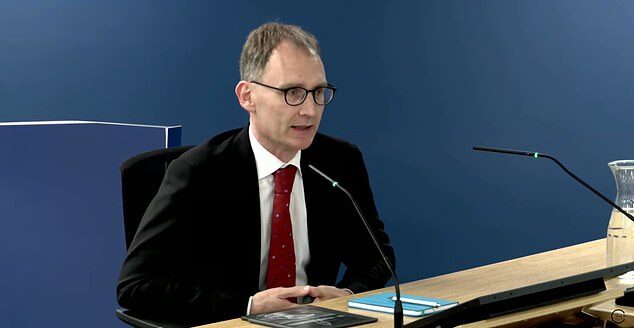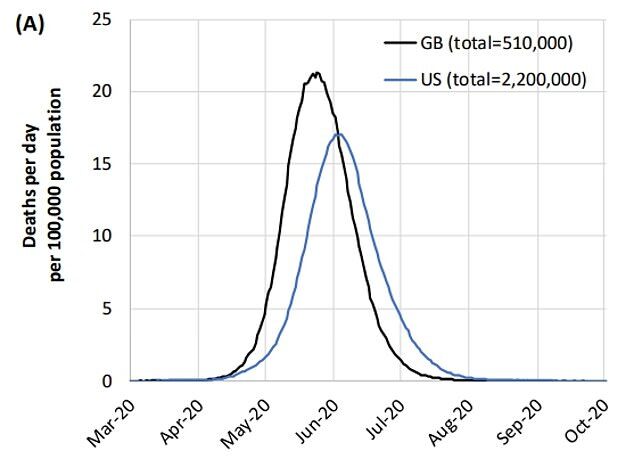
Professor Neil Ferguson's terrifying March 2020 models warned that 500,000 Brits would die unless tougher action was taken to curb the virus's spread.
It spooked Boris Johnson into adopting draconian restrictions that saw the country told they 'must stay at home'. Vaccines — considered the only safe route out of the pandemic — were still months away from being deployed.
But Professor Ferguson, who quit his role as a SAGE adviser two months after being caught breaking social distancing rules to meet his married lover, today insisted he didn't tell officials to plunge the country into a lockdown.
He told the UK Covid-19 Inquiry that the situation was 'a lot more complex'.
The inquiry is in its second module, which is examining core UK decision-making and political governance.
Hugo Keith KC asked: 'Do you feel that you did confine yourself to the provision of scientific advice, or did you become, despite your best endeavours, irrevocably involved in determination of policy?'
Imperial College London's Professor Ferguson, nicknamed 'Professor Lockdown' for his infamous modelling, said it was a 'difficult question to answer'.
He said: 'I know I'm associated very much with a particular policy.
'But as you'll be aware from the evidence I've given in my statement and statements of evidence, the reality was a lot more complex.
'I don't think I stepped over that line to say "we need to do this now".
'What I tried to do was at times, which was stepping outside the scientific advisory role, to try and focus people's minds on what was going to happen and the consequences of current trends.'
The epidemiologist, who today also apologised to the inquiry for breaking lockdown rules himself, drew heavy flak for his team's modelling on the Covid pandemic.

It spooked then-PM Mr Johnson into lockdown. It saw schools, shops and hospitality close, social distancing come into force and Brits only allowed to exercise outdoors once a day.
Experts largely accepted that the economically-crippling measures were vital to control the spread of the virus, as there was no vaccine to prevent severe illness and stunt hospital admissions at the time.
But other epidemiologists and public health scientists shared 'grave concerns' about the collateral damages of such policies on the NHS and other parts of society in future.
The wave ended up being much less severe than Professor Ferguson predicted, leading some to call the modelling 'totally unreliable'.
Others insist that lockdown is why cases didn't reach the eye-watering levels set out in Professor Ferguson's models.
He made other gloomy models throughout the pandemic, and later accepted that some were 'off'.
The UK has logged 230,000 fatalities that have Covid on the death certificate since the pandemic began. Not all of these will have been caused by the virus.
Some 55,500 were logged during the first three months of the pandemic, official figures show.
Despite his models suggesting the death toll would be much higher, Professor Ferguson told the inquiry that he was initially wary about the idea of imposing Covid curbs, such as closing down schools or full lockdowns — known as non-pharmaceutical interventions (NPIs).
Asked why he did not recommend such measures before mid-March 2020, he said: 'In part because of my belief that it isn't the role of scientific advisers to determine policy, but also because I was very conscious of the huge economic and social costs which would be entailed by long-term and intensive use of NPIs.'
Professor Ferguson noted that his models didn't take 'spontaneous' changes in behaviour — such as Brits choosing to mix less to avoid catching the virus — into account.
But he said his early estimates for the case fatality ratio (CFR) — the number of confirmed cases that die from the virus — and calculations that one third of infections would not have symptoms were largely correct.
Professor Ferguson expressed his 'frustration' that the Government's scientific committee SAGE took 'so long' to adopt the figures.
Covid models used throughout the pandemic tended to set out a lower, middle and higher estimate for projections in cases, hospitalisations and deaths.
However, Professor Ferguson told the inquiry he was 'always uncomfortable' with the central estimates of his models being labelled the 'reasonable worst case scenario' because it 'makes it sound like it's unlikely'.
He claimed that in early 2020, he didn't believe that the UK's containment approach — border controls and only testing hospital cases — would work and would only suppress a small number of cases.
But consensus statements from SAGE, read out to the inquiry, stated that there was no evidence to move away from this policy.
Professor Ferguson claimed reservations from England's Chief Medical Officer Sir Chris Whitty was the 'most significant driver' for that statement as he did not want to be the first country to move away from Covid containment policies.
The inquiry saw extracts from emails sent between Professor Ferguson and Government officials and scientists, including at 3:30am with Sir Chris as the pandemic hit the UK.
Asked why he did not recommend measures before mid-March 2020, Prof Ferguson said: 'In part because of my belief that it isn't the role of scientific advisers to determine policy, but also because I was very conscious of the huge economic and social costs which would be entailed by long-term and intensive use of NPIs.'
Professor Ferguson also claimed the Government failed to communicate its Covid strategy with SAGE.
Academics also privately asked officials if they realised the true scale of the crisis, he said.
He told the inquiry: 'There was a complete Chinese wall between SAGE and Cobra.
'It was not as if SAGE meetings started with a readout from Cobra about what the government were thinking and planning to do.
'We had almost no visibility in fact, in terms of operational planning.'
He added: 'The artificial divide between scientific advice and then operational planning and response was a hindrance.'
Professor Ferguson said that by early March 2020, he and fellow SAGE member, John Edmunds, a professor of infectious disease modelling at the London School of Hygiene and Tropical Medicine privately raised the alarm with officials.
He said they both 'started talking in the margins to Government attendees, saying: "Do you know what this is going to be like?"'
Despite resigning from his Government role after his rule-breaking affair was revealed, Professor Ferguson continued to sit on the Scientific Pandemic Influenza Group on Modelling (SPI-M) committee and the New and Emerging Respiratory Virus Threats Advisory Group (NERVTAG).
It comes after a Government scientist today told the inquiry that Covid deaths in the first wave of the pandemic could have been lower if the UK went into lockdown just two weeks earlier.
Professor Steven Riley, who worked alongside Professor Ferguson at Imperial College London during the pandemic, said lockdown should have been imposed on March 9, 2020.
The infectious disease expert, who now leads the data, analytics and surveillance group within the UK Health Security Agency, said data shows that people began to alter their behaviour on or around March 16, a few days ahead of the stay at home order.
But he said that Government action should have been taken sooner.
'My view is that the first national period of stringent social distancing (lockdown) should have been introduced on or around 9 March 2020,' he wrote in his witness statement to the inquiry.
Asked to elaborate, he told the inquiry: 'Once we had lab confirmed deaths in ICUs (intensive care units) with no travel history, no obvious connections to any out of country social networks, even a handful of those would indicate that we would be rapidly progressing in our epidemic.'
He added: 'We've got a lot of data about how social mixing changed over this period and actually on or around March 16 seems to be when everybody did start to change their behaviour.
'So I think the best way to talk about this is to say: had we achieved that rapid reduction in mixing earlier than the 16th then the peak height would have been lower, and the area under the curve for the first wave would have been less, and potentially quite a bit less.
'And the area under the curve is proportional to the number of deaths in a very kind of crude but useful way.'
It comes as evidence submitted to the inquiry by a leading think tank suggests that the NHS and social care in the UK is still 'highly vulnerable to future shocks' to the system.
The Health Foundation said in a statement that a 'lack of health service capacity constrained the response to Covid-19'.
'Without sustained investment in increasing resilience, response to future health threats are likely to be similarly hampered,' it said.
The UK entered the pandemic with fewer doctors, nurses, hospital beds and equipment compared to similar countries, according to the think tank.
Meanwhile, funding growth for the NHS was 'severely constrained' prior to the pandemic.
'The pre-existing constraints in our health and care system risk prolonging the recovery of services after the pandemic and, without sustained investment, leaves the UK highly vulnerable to future shocks,' the authors wrote.



Just another bullshit story from a Nazi who wants to save his ass from a hanging for crimes against humanity.